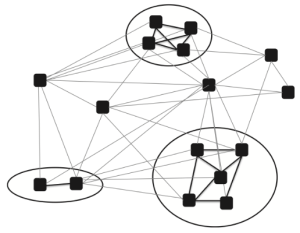Structural Balance in the Social Network of Animals
An academic journal about animal behavior included a specific study on observing trends in the social network of wild rock hyraxes, also known as Procavia capensis. The data was intended to be used for predicting the behavior of hyraxes and drawing conclusions regarding the structural balance of the network and the effect of gender on the social network. Since analysts were seeing a large number of positive relations between hyraxes, they decided to factor in the likelihood of having more positive triads because there are so many positive relationships. It was also predicted that since male hyraxes tend to be more aggressive than females, unbalanced triads with only females would more likely to change to all positive while triads with at least one male would likely change to all negative or two negative and one positive. The data was organized into a visual diagram to indicate nodes and relations, along with the groups they have noticed.
The black lines represent positive edges whereas the gray lines represent negative edges. The nodes are also organized into groups based on the positive connections between multiple nodes. Balanced triads ended up being more common than expected and unbalanced triads ended up being less common than expected. The model controlling the degree distribution indicated that there was a strong structural balance in the networks.
This topic relates to the material discussed in class because we learned about structural balance theory and how it affects ties in relations due to the triadic structure. The nodes described in the journal are similar to how we used nodes in class to represent people in a social network but the journal focuses more on each node being an animal. This subject also relates to how we discussed allies and enemies in class to differentiate between positive and negative relationships. From this study, it appears that hyraxes can also have positive and negative relations which relates to the various combination possibilities discussed in class. Also, as indicated by the graph there are triadic structures with all positive, all negative, and one positive with two negatives. These are all part of the possibilities that we have seen in lecture and in the homework assignments. Lastly, the groups that are organized in the diagram relate to a concept we introduced in the beginning of the semester where you can identify groups in a network based on their connections between each other since you can infer that they are related. This diagram shows this relationship through the positive ties and circular division.
Source: https://www.tau.ac.il/~geffene/PDFs/93-Anim_Behav_2013b.pdf

